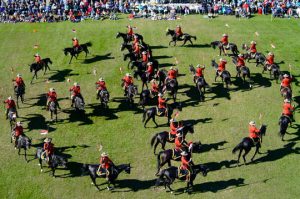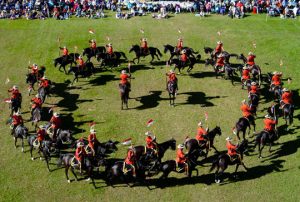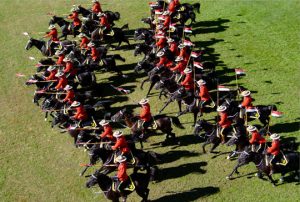THE RCMP MUSICAL RIDE by BARNEY MOORHOUSE For Reproduction Rights Call Access 1.800.893.5777
Who has never heard of the Royal Canadian Mounted Police Musical Ride? Well, to my astonishment, apparently a number of people that I talked to. Which perhaps is another good reason for the RCMP performances in 40 communities this year, from May to October, not only in Canada but also in the U.S. and in England where they performed from May 12 to 15,for Queen Elizabeth in celebration of her 90th birthday at the Royal Windsor Horse Show.
The “Horsemen”, as they were known to us as we were growing up, don’t limit their performances to such prominent occasions and places. For example, on Labour Day, September 5, 2016, the troop demonstrated their horsemanship skills accompanied by music at the village of Apsley, Ontario. As an aside, novelist R.D. Lawrence once told to me that he could never say “Apsley”; it always came out “As-pley” and confided that he could never live in a place whose name he couldn’t pronounce. So he moved to Gooderham.

Apsley claims to be the smallest municipality in Peterborough County in terms of population, though the seasonal population is estimated at 12,000. The Lions Club began planning this special event four years previously under the direction of Lion and retired RCMP Officer Jack Nelson. They arranged for a high noon performance when the sun beat down mercilessly under clear 30 degree C skies, considerably warmer than the norm for that time of year. And although the spectators may have felt a tad uncomfortable, one can only try to imagine the 32 equestrians and their charges performing carefully choreographed manoeuvres such as the wagon wheel, rings, clover leaf, thread the needle and the climatic crowd pleasing charge in such conditions.

When I purchased my tickets I learned that approximately 2000 had already preceded me. By Labour Day that number apparently had doubled. The Lions’ rationale for high noon was in consideration of Toronto folk who could conceivably stay for the performance before hastening home for the opening of school the following day.
Following the performance, during what the RCMP refers to as the “Meet & Greet”, the mounted riders formed a circle around the field so kids of all ages could pat the horses and chat with the riders.
Colleen Pulcine of the R.C.M.P. told me that the Musical Ride is composed of a full troop of 32 riders and horses, plus the officer in charge. “It consists of the execution of a variety of intricate figures and a cavalry drill choreographed to music.”
FYI
All members of the Musical Ride are full time policemen and women; they have volunteered for this special duty for a period of three years. Members must have completed a minimum of two years of active police work before applying to the Ride. 45 members are chosen to attend a five week Basic Equitation Course in Ottawa. No riding experience required. Riders are evaluated on their riding ability/ aptitude, conduct, relationship with other members, initiative/effort, appearance and responsibility/reliability. 12-15 riders are chosen to return for the six month Intermediate Equitation Course ready to replace those who have completed their three year rotation and who will return to their regular duties across Canada.

“In theory, if the horses and riders are well trained, it should take 16 weeks to produce a show worthy of the Musical Ride.” (Pulcine)
The RCMP breeds Hanoverian horses, 16 to 17 hands high, weighing 523 kg (1,150 lbs.) to 635 kg (1,400 lbs.) at Remount Detachment near Pakenham, Ontario. Horses begin their training at age 3 and they try out for the ride at age 6. Some perform for over 10 years; some for just a few years. “Just like humans, it depends on the horse.” Upon retirement they become class horses training new riders.
Of interest, this year’s ride includes 15 female officers. Another aside. In the mid 1960s, having graduated grade 13 in Ontario, I went to the RCMP recruiting office on Russel Street in Toronto. At that time only males were recruited, they had to be single and the basic height requirement was 5 foot 8 inches. I believe there was also a weight requirement. After a year of service one could get married; but only with permission from the force. And, all new recruits went to equitation school until 1966. Times change!
As seen in photographs the riders wear their Red Serge which refers to the jacket of the dress uniform. It consists of a scarlet British-style military pattern tunic, complete with a high-neck collar and blue breeches with yellow stripe identifying a cavalry history. Riders carry extra uniforms. It depends on the member as to how many.
SOME HISTORY
Formed in 1873 by the Parliament of Canada, the North West Mounted Police relied on skilled riders to carry out their police duties in the vast and sparsely populated prairies. To alleviate the monotony of endless riding drills members would compete amongst themselves performing riding tricks and skills. Perhaps the first public performance took place at Fort Macleod in 1876. The first riding school was established in Regina in 1886. During the winter of ’87 they held five performances at the Regina barracks. The Ride was only performed in the winter when a large number of Mounties stayed in Regina awaiting the resumption of their summer patrols. The Riding School at Depot burned later in 1887 and there is no record of another Musical Ride until 1901 when they performed at Brandon, Manitoba and Qu’Appelle, Saskatchewan. In 1908 the Ride achieved two firsts. It performed for the first time outside western Canada (Quebec City) and for the Prince of Wales – the first member of the Royal Family to take one in.

Musical Rides were cancelled in 1914 (WW1) and not held again until 1920 when the now Royal NWMP absorbed the Dominion Police, the federal police force in eastern Canada and became our national force, aka the RCMP. Headquarters was moved to Ottawa establishing “N” Division at Rockcliffe, Ontario. “N” Division immediately organized a Musical Ride and performed at Lansdowne Park on May 24, 1920 and at Brockville, July 1st. They first performed in England and the U.S. in 1930. World War Two ended performances until 1948.
In 1953 they performed at the coronation of Queen Elizabeth 11. Ministerial authority placed the Musical Ride on a permanent footing in 1961. Women were first accepted as uniformed officers in 1974.
Photos – courtesy of Her Majesty the Queen in Right of Canada as represented by the RCMP. 2017
